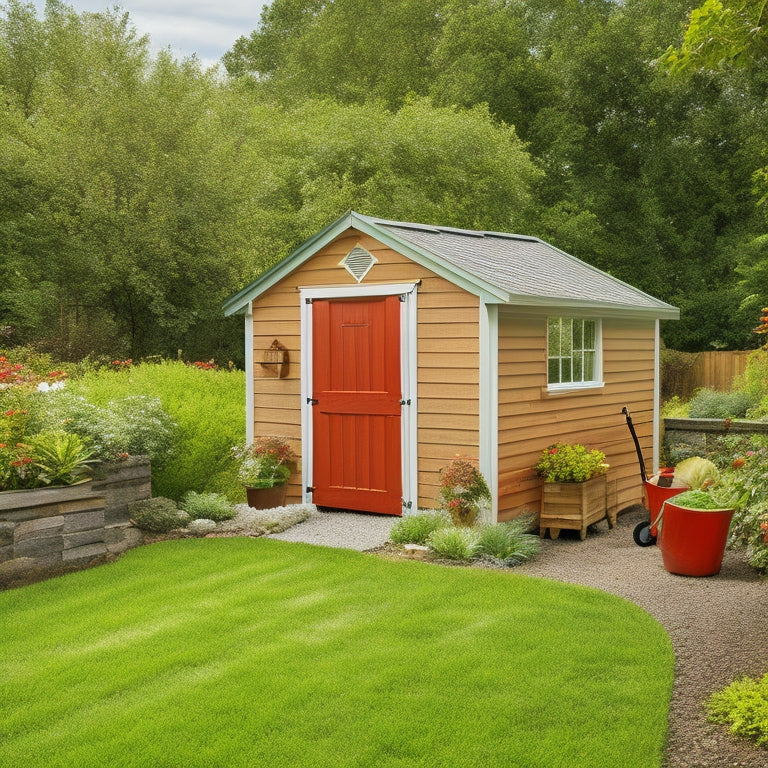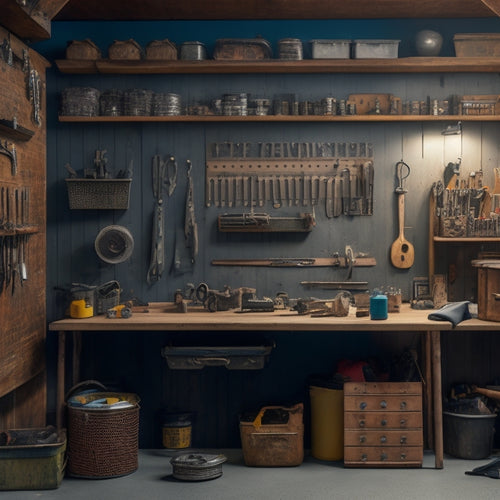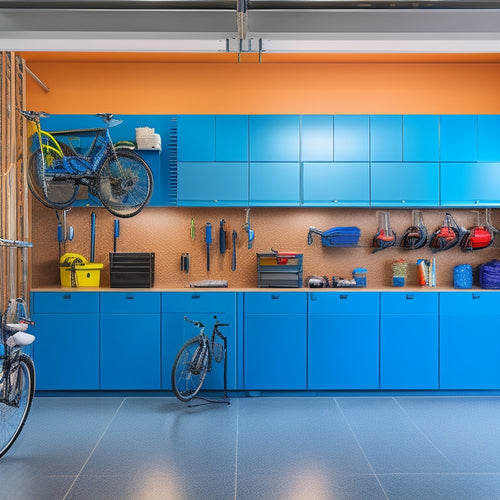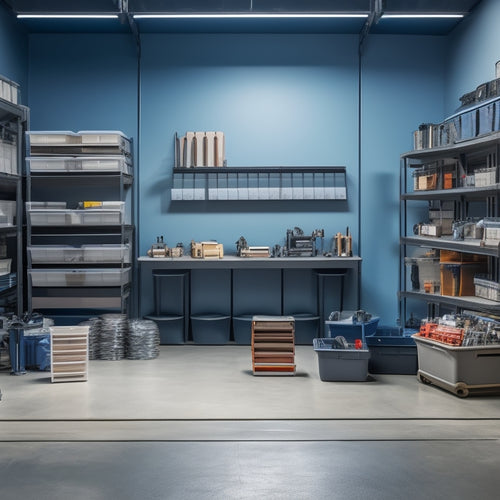
Small Spaces Small Sheds for Tool Storage
Share
You're looking to optimize your small outdoor space with a compact tool shed that efficiently stores your equipment, supplies, and seasonal decorations while minimizing clutter and enhancing safety. Start by evaluating your available space and the tools you need to store, considering size, material, and design to guarantee a functional and visually appealing shed. Plan for adjustable shelving, hooks, and pegboards to maximize storage capacity, and don't forget to account for clearance and local building codes. With careful planning, you can create a customized tool storage solution that streamlines your workflow and keeps your yard organized, and there's more to investigate on how to get it just right.
Key Takeaways
- Choose a shed size that fits available space, considering tool storage needs and yard aesthetics to maximize functionality and minimize clutter.
- Plan for adjustable shelving and hooks to maximize storage capacity and ensure comfortable movement within the shed.
- Select durable building materials, such as pressure-treated plywood and metal frames, to ensure the shed withstands weather conditions.
- Implement tool categorization strategies and label storage areas for easy identification and maintenance of organization.
- Consider DIY or pre-assembled sheds based on customization needs, budget, and desired level of convenience.
Benefits of Small Tool Sheds
By situated at the edge of your lawn or tucked behind the garage, a small tool shed can be a significant element for homeowners and DIY enthusiasts alike. This compact structure provides a dedicated space for storing tools, equipment, and supplies, keeping them organized, out of the way, and easily accessible.
One of the primary tool shed benefits is the creation of compact storage, allowing you to maximize your available space while minimizing clutter. With a small tool shed, you can store items like lawn mowers, gardening tools, and seasonal decorations, freeing up essential space in your garage or basement.
Additionally, a tool shed can help you stay safe by keeping hazardous materials, like chemicals and sharp objects, locked away from children and pets. By keeping your tools and equipment organized and within reach, you'll be more efficient and productive, making your DIY projects and yard work a breeze.
Choosing the Right Tool Shed
You'll need to evaluate the size of your tool shed based on the space you have available and the tools you need to store.
Think about the types of tools you'll be storing and how you'll organize them to maximize storage capacity.
Shed Size Considerations
When selecting a tool shed, considering the size of the shed is paramount, as it directly correlates with the amount of storage space available for your tools and equipment.
You'll want to make certain the shed dimensions accommodate your needs without overwhelming your yard or compromising your workflow.
Opt for a shed that provides an ideal layout, allowing you to efficiently store and access your tools. A well-planned interior will prevent clutter and reduce the risk of accidents.
Consider a shed with adjustable shelving and hooks to maximize storage capacity.
Measure your yard and consider the space available for the shed.
You'll need to verify there's enough clearance around the shed for easy access and maintenance.
Additionally, check local building codes and regulations to guarantee compliance.
Tool Storage Needs
Your tool storage needs are unique, and choosing the right tool shed requires careful thought of the specific equipment and supplies you need to store. You'll want to reflect on the size and type of tools, as well as the frequency of use. This will help you determine the ideal layout and design of your shed.
Contemplate the weight and bulk of your tools, and how you'll need to access them. For example, if you have heavy equipment like a lawn mower or generator, you'll want to make sure the shed floor can support the weight. You may also want to think about installing shelves or hooks to keep smaller tools organized and within reach.
Space optimization is key in a small shed. Look for features like adjustable shelves, pegboards, and bins to maximize storage capacity.
Tool accessibility is also essential – you'll want to be able to easily retrieve and store tools without straining or risking injury. By carefully evaluating your tool storage needs, you can choose a shed that meets your specific requirements and helps you work more efficiently and safely.
Measuring Your Available Space
Several factors come into play when determining the ideal size of your small shed for tool storage, but none are more critical than the available space where the shed will sit.
You'll need to accurately measure the area to guarantee your shed fits comfortably, allowing for safe and easy access.
To optimize space, start by measuring the length, width, and any obstructions, such as trees, slopes, or power lines.
Take note of the direction of sunlight and wind to determine the best shed orientation.
Consider the space required for doors and windows, as well as any necessary clearance for opening and closing them.
Use measuring techniques like creating a scale drawing or taking photos with a measuring tape to visualize your space.
This will help you identify potential issues and make informed decisions about your shed's size and placement.
Don't forget to check local building codes and regulations to guarantee compliance.
Small Shed Design Considerations
You'll want to contemplate the overall shed size, ensuring it fits your available space while accommodating your tool storage needs.
Next, you'll need to decide on materials and colors that complement your yard's aesthetic.
Shed Size Matters
Behind every efficient tool storage shed lies a well-planned design, and it all starts with the right size. You need to take the shed dimensions carefully to guarantee you can fit all your tools and equipment safely and efficiently. A shed that's too small can lead to clutter, making it difficult to find what you need and increasing the risk of accidents.
When determining the best layout, think about the types of tools and equipment you need to store. Will you need shelves for bins and containers, or a workbench for projects? Reflect on the size and shape of your tools, such as lawn mowers, trimmers, and other bulky equipment.
You'll want to ascertain you have enough clearance to move around the shed comfortably and access your tools easily. Aim for a shed size that provides enough floor space to accommodate your tools and allows for an ideal layout.
A well-planned shed will help you stay organized, increase productivity, and reduce the risk of accidents. By getting the size right, you'll be able to create a safe and functional tool storage space that meets your needs.
Material and Color Options
As you finalize your shed's layout, it's time to contemplate the material and color options that will bring your design to life. You'll want to choose materials that not only fit your design aesthetic but also provide durability and weather resistance.
Wood types like cedar, pine, and spruce are popular choices for sheds due to their natural resistance to rot and insects. Metal finishes, such as galvanized or powder-coated steel, offer a low-maintenance option that can withstand harsh weather conditions.
When it comes to color schemes, consider the surroundings and the style of your home. You can opt for a bold, contrasting color or blend in with a more subtle, earthy tone.
Paint options range from traditional oil-based to eco-friendly latex and acrylic paints. Be certain to select a paint that's specifically designed for outdoor use and can withstand the elements.
Additionally, consider using eco-friendly materials, such as reclaimed wood or recycled metal, to reduce your shed's environmental footprint.
Ultimately, your material and color choices will greatly impact the overall look and functionality of your shed, so choose wisely to guarantee a safe and durable storage space.
Storage and Accessibility
Three essential aspects of small shed design are storage capacity, accessibility, and organization. You want to maximize your tool storage while maintaining a safe and efficient workspace.
Consider the following design elements to accomplish this:
-
Vertical storage: Install shelves, hooks, or pegboards to take advantage of your shed's vertical space. This will keep frequently used tools within easy reach and prevent clutter from building up on the floor.
-
Multi-functional furniture: Choose workbenches or tables with built-in storage, such as cabinets or drawers, to keep essential tools and supplies close at hand.
-
Wide doors and aisles: Verify your shed has wide enough doors and aisles to accommodate easy movement and access to tools and storage areas. This will prevent accidents and injuries caused by tripping or squeezing through tight spaces.
- Task-oriented zones: Divide your shed into zones dedicated to specific tasks, such as a potting area or a woodworking station. This will help you stay organized and focused, reducing the risk of accidents caused by clutter and confusion.
Tool Shed Organization Ideas
Within your compact tool shed, every inch counts, and maximizing storage space is crucial for efficiency. To achieve this, apply tool categorization strategies by grouping similar tools together, such as hand tools, power tools, and lawn care equipment. This helps you quickly locate the tool you need and prevents clutter buildup.
Next, leverage vertical storage solutions to make the most of your shed's ceiling height. Install shelves, hooks, and pegboards to store items like bins, baskets, and tools with long handles. Label each storage area to guarantee you can easily identify where items are stored. This visualization will help you maintain organization and prevent tools from getting lost or damaged.
Consider a slatwall or pegboard with movable hooks and bins to store frequently used items, keeping them within easy reach.
Implementing these organization ideas will create a safe and functional workspace, allowing you to work efficiently and effectively in your compact tool shed.
Selecting the Perfect Shed Size
When selecting the perfect shed size, you'll need to contemplate the space available in your yard, bearing in mind any obstacles or constraints.
You'll also want to measure the area carefully to guarantee your shed fits comfortably, leaving enough room to maneuver around it.
Shed Size Considerations
Most homeowners can attest that a small shed's purpose is often compromised by inadequate storage space. You need to strike a balance between the shed's size and the space available in your yard.
When selecting the perfect shed size, consider the following factors:
-
Shed dimensions: Think about the size of the items you'll be storing. Will you need to store a lawn mower, bicycles, or other bulky equipment? Verify the shed's dimensions can accommodate these items comfortably.
-
Optimal layout: Consider the layout of your shed. Will you need shelves, hooks, or a workbench? A well-planned layout will help you make the most of the available space.
-
Accessibility: Confirm the shed's size allows for easy access to the items you store. You don't want to be crawling over obstacles to reach what you need.
- Aesthetics: Finally, consider the visual impact of the shed on your yard. Choose a size that complements your yard's surroundings and doesn't overwhelm the surrounding area.
Measuring Available Space
Your yard's available space serves as a blueprint for determining the perfect shed size. To optimize space, start by measuring the length, width, and any obstacles in the area where you plan to install the shed.
Consider the space required for doors, windows, and any other features you want to include. Take note of any slopes, curves, or uneven terrain that may affect the shed's placement.
Next, create a rough layout plan, considering the shed's footprint and any necessary clearance areas.
Think about how you'll access the shed and whether you need to accommodate any neighboring structures or plants. Measure the space multiple times to verify accuracy and account for any potential setbacks or restrictions.
Storage Capacity Needs
Now that you've mapped out your yard's available space, it's time to focus on the amount of storage capacity you need.
You'll want to evaluate the types and quantities of tools and equipment you need to store. Think about the compact organization you can achieve with vertical storage options like shelves and hooks.
- What's the total volume of your tools and equipment?
- Do you have bulky items like lawn mowers or bicycles that require extra space?
- Will you need room for workbenches or repair stations?
- Are there any specific tools or accessories that require special storage considerations, such as fuel or chemicals?
Answering these questions will give you a better sense of the storage capacity you need.
Then, you can select a shed size that fits your needs, ensuring you have enough room for everything without feeling cramped or overwhelming.
Small Shed Building Materials
The shed's structure demands careful consideration of building materials to guarantee durability and resistance to the elements. You'll want to choose materials that can withstand harsh weather conditions and heavy tool storage.
For the walls and floor, consider plywood options like pressure-treated or marine-grade plywood for added protection. Metal frames provide a sturdy base and can be made from galvanized or stainless steel for corrosion resistance. Insulation choices, such as foam board or fiberglass, will help regulate the shed's temperature and reduce condensation.
When it comes to flooring materials, opt for durable options like concrete, asphalt, or PVC. Roofing types like asphalt shingles, metal roofing, or corrugated roofing provide excellent protection from the elements.
Finish the exterior with a weather-resistant paint finish, and select door styles that can withstand heavy use. Strategically place windows for natural light and ventilation solutions, such as vents or skylights, to maintain a healthy indoor environment.
DIY or Pre-Assembled Sheds
Selecting the right approach to building your small shed for tool storage is critical to its overall success. You have two primary options: DIY or pre-assembled sheds. Each has its advantages, which you should carefully consider before making a decision.
DIY Advantages:
- Allows for customization to fit your specific tool storage needs
- Can be a cost-effective option, especially if you have the necessary skills and tools
- Provides a sense of accomplishment and ownership
- Enables you to make changes or repairs as needed
On the other hand, pre-assembled sheds offer convenience and speed. You can quickly assemble the shed and start storing your tools, without worrying about measuring, cutting, and assembling individual components.
This approach is ideal if you're short on time or lack DIY experience. However, be prepared for a potentially higher cost and limited customization options.
Tool Shed Maintenance Tips
How often do you inspect your tool shed for signs of wear and tear, or simply assume it'll withstand the elements and heavy use?
Regular tool shed maintenance is essential to guarantee your tools remain organized, protected, and easily accessible. Start by checking the roof for damaged or missing shingles, and clear any debris that may be obstructing water flow.
Inspect the walls and foundation for cracks, rot, or pest damage, and address any issues promptly.
Next, focus on tool maintenance by cleaning and lubricating your tools regularly. This will prevent rust and corrosion, assuring they remain in good working condition.
Organize your tools by category and frequency of use, and store them in a way that maximizes storage efficiency. Keep frequently used tools near the front of the shed, and less frequently used tools towards the back.
Space-Saving Tool Storage Ideas
By keeping your tools organized and protected through regular maintenance, you'll have more time to focus on maximizing your tool shed's storage capacity.
Now, it's time to get creative with space-saving tool storage ideas.
-
Employ vertical storage by installing shelves, hooks, and bins that reach up to the ceiling. This will help keep your tools organized while keeping the floor clear for easy movement.
-
Invest in multi-purpose furniture, such as a workbench with built-in storage or a shelving unit with a built-in vice. This will help reduce clutter and increase functionality.
-
Consider using stackable containers or bins to store small items like nuts, bolts, and screws. Label each container so you can easily find what you need.
- Hang tools like bikes, hoses, or extension cords on the walls or ceiling to free up floor space and keep them organized.
Frequently Asked Questions
Can I Build a Tool Shed on a Slope or Uneven Ground?
You can build on a slope, but you'll need to take into account slope considerations, ensuring your foundation is level and secure. You'll likely opt for a foundation type like a helical pier or a post-and-beam system to anchor your shed safely.
How Do I Protect My Tool Shed From Pests and Rodents?
As you fortify your sanctuary, remember that pests and rodents are sly invaders, waiting to pilfer and destroy. To outsmart them, you'll need to seal all crevices, install rodent-proof barriers, and maintain a clean, dry environment, ensuring your tool shed remains a pest-free haven.
Can I Add Electricity to My Small Tool Shed?
When adding electricity to your shed, you'll need to prioritize electrical safety. Hire a licensed electrician to install shed lighting, ensuring proper wiring, grounding, and insulation to prevent shocks and fires.
Are Metal Tool Sheds More Durable Than Wooden Ones?
As you envision a fortress for your tools, you'll find metal sheds stand like sentinels, impervious to rot and pests, whereas wooden ones are vulnerable to decay and termite attacks, making metal sheds a more durable, low-maintenance choice.
Do I Need a Building Permit for a Small Tool Shed?
You'll need to check local shed regulations, as permit requirements vary, but typically, you'll need one if your shed exceeds a certain size or is wired for electricity, ensuring your storage solutions meet safety standards.
Conclusion
As you stand in your cluttered backyard, surrounded by scattered tools and equipment, the humble small shed stands as a lighthouse of hope, a haven of organization and efficiency. Yet, it's not just a utilitarian afterthought - it's a design opportunity, a chance to craft a miniature work of art that enhances your outdoor space. With careful planning and execution, your small tool shed can be a concert of form and function, a harmonious blend of aesthetics and practicality.
Related Posts
-

Design Considerations for a Custom Pegboard
When designing a custom pegboard, you'll want to start by evaluating your storage needs, considering factors like too...
-

Top Garage Storage Bins for Organization and Style
You can enhance your garage's style and organization with the right storage bins. Top brands like Rubbermaid, Suncast...
-

How to Maximize Storage Space With Parts Storage Bins
To maximize storage space with parts storage bins, start by evaluating your available storage space and examining you...


